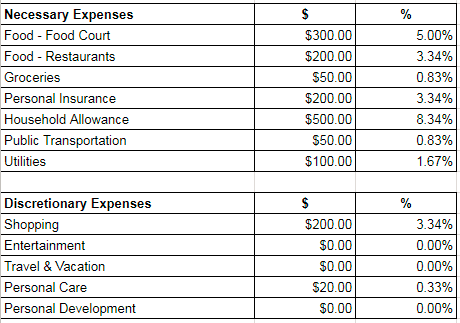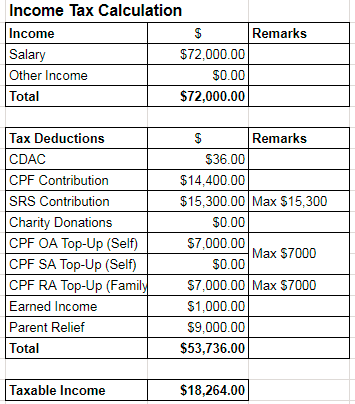Build a budget with this simple salary allocation budgeting template
We’ve crossed the middle of the year again and if you’re as lucky as I am, you should have been informed of your salary increment for 2018.
This year, I got a small increment of $195 in my monthly payroll so that’s an additional 195 one-dollar soldiers awaiting for deployment every month!
I checked my salary allocation budget that I update every year and it looks like there’s no additional expenses incurred so far. That’s good news to me because all the 195 one-dollar soldiers will be deployed to investment wealth accumulation.
Every week, I’ll be sharing practical tips and invaluable knowledge to guide you on your path to financial independence.
What’s a salary allocation budget?
A salary allocation budget is essentially just a budget plan.
“A goal without a plan is just a wish.”
– Antoine de Saint-Exupéry –
To plan how every dollar of my salary is used each month, I designed a salary allocation budgeting template. I update my salary allocation budget each year to ensure every dollar is put to good use.
Plan how much is saved and how much is spent
Personally, I strive to maintain a savings rate of around 50-70%. Having a budget helps me build a plan to achieve this.
To date, I’ve managed to maintain a savings rate of 61.3% to date for 2018. In my opinion, that’s a pretty decent achievement and I’m hoping to maintain the savings rate through the rest of the year.
I can’t say I would have achieved this result without proper planning and ensuring I do not overspend in each budget category.
Use this salary allocation budgeting template to plan your retirement
In this article, I’m sharing my salary allocation budgeting template to help you plan your monthly budget.
To use my template, click here to open my salary allocation budgeting template and save a copy in your Google drive.
In my template, I’ve added a fake persona of someone who has a monthly income of $6,000 to help you understand how the final budget should look like. I try to keep it super simple to use and not confuse myself with rocket science mathematics for budgets. Here’s how you use them.
Step 1: Enter your monthly income
Enter your monthly salary income and other income sources, if any. For self-employed individuals, I would suggest using an average of your annual income as a forecast.

Step 2: Input your CPF contributions and taxes
Before we pay ourselves, we have pay the government first. I’ve added CDAC and CPF contributions along with Income Tax and Property Tax here. But if you have other forms of taxes that you are paying, feel free to add them here.

Step 3: Pay yourself first with savings
After paying the government, we then pay ourselves next. Here is where I pay myself first by chalking up my savings, and trying to max out my tax deductions.

Step 4: Identify necessary and discretionary expenses
I sorted my expenses into 2 expense categories – necessary expenses and discretionary expenses.
Necessary expenses are expenses that are necessary for living. Usually they are the ‘needs’ portion of my living expenses. I find that food and transportation form the bulk of my monthly necessary expenses whereas the rest are pretty standard and don’t change much.
Discretionary expenses are expenses that I don’t consider necessary for living. They are typically the ‘wants’ portion of my living expenses. These are typically the monsters of my expenses and the ones that I have to rein in tight to prevent overspending.

Step 5: Validate your cash inflow and outflow for surplus/deficit budget
This is the final check to validate that you aren’t spending beyond your means. There should be a tiny surplus from my monthly budget which means that your Total Cash Outflow does not exceed the Total Cash Inflow.
If your surplus is too high ($100 or more), it shows that you could potentially save more money. Likewise if you’re looking at a deficit, you need to adjust your savings or expenses to balance things up (because we don’t have huge cash reserves to operate on budget deficits).
You can also examine your Total Savings versus your Total Expenses to see if you are happy with how much you are saving (52.41% in this example) as compared to how much you are spending?

Step 6 (optional): Check your total taxable income for the year
If you hate paying unnecessary taxes to the government as much as I do, here’s a bonus item for you.
I’ve added an Income Tax Calculation to take into consideration the taxable income, along with the tax deductions that I’m entitled for each year. Most of these tax deduction items will make use of your Salary Allocation Budget to do the necessary computation.
The only items you need to manually change is Charity Donation. As this is not a full list of tax deductions available, feel free to add other tax deductions that you are entitled to.

I’ve been using my Salary Allocating Budgeting Template to plan my monthly budget for 2 years now and I’ve been consistently updating it to suit my needs.
I hope you find my template useful for your budget planning.
Please share your thoughts on the comments below.


Thanks for this. The template is indeed very useful 🙂 One of the better finance blogs out there. Incidentally i’m 31 as well.
Thank you! It’s very heartening to hear that someone found it useful.
I’m no longer 31 though. It’s been a 4 years since I started this blog. I really need to update the ‘About’ page. 🙂
Haha! May i ask if you are single or attached or planning to get married? I’ll be getting married and i’m moving to a new place and all the upcoming expenses etc can be quite overwhelming but your blog keeps it simple and easy to understand.
I’m single and don’t have plans to change this status right now. I’m sure the expenses are piling up for you as you transition to a different life stage.
What I’d advise is to have a discussion with your fiancee about financial planning. It’ll be good to draw a timeline and plot out the various milestones with the expenses involved. Once the two of you have a clearer picture of your future, both of you can collectively agree on changes that need to be made to your spending habits, saving and investment objectives.
Hope this helps. 🙂
Hi can i ask why cash savings are not included in the total savings in the template.
Hi Gary,
You can always change one of the saving items as Cash Savings to suit your needs. It’s just that in my case, I prefer to be fully invested with little cash savings on hand. 🙂